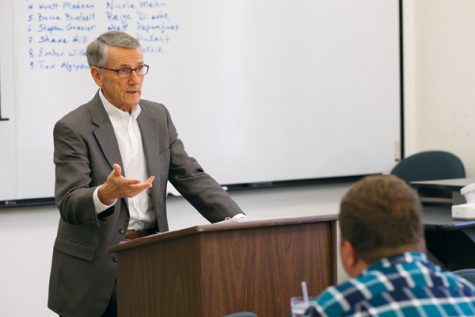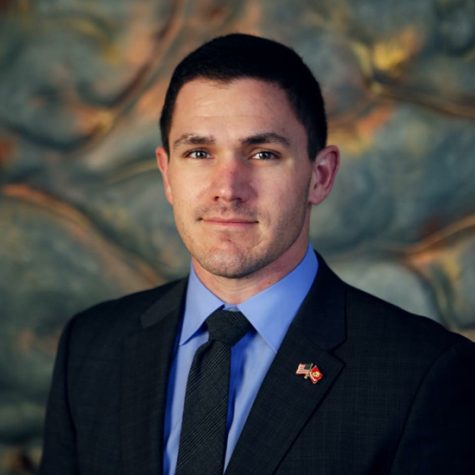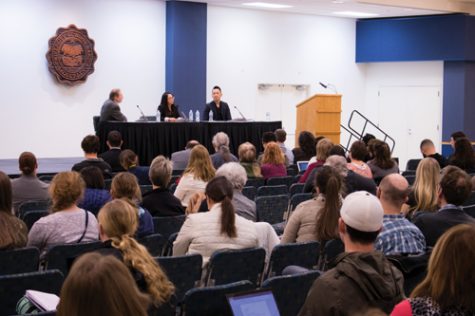Addressing sexual assault on the college campus
Dakota Student / Nicholas Nelson
Lieutenant Don Rasmuson is a UND police officer and intellegence officer in the Department of Public Safety.
April 28, 2017
Handling sexual assault on a college campus poses unique problems that are forcing institutions to expedite the process. In an attempt to ensure a victim doesn’t run into her or his attacker on the way to class, university administrations rely on the “preponderance of evidence,” as opposed to the more popular “beyond a reasonable doubt.”
The “preponderance of evidence” is typically used in civil court cases and requires that 50.01 percent of evidence provided in a case either confirm or deny a sexual assault has taken place. While this process ensures a decision is made quickly, it also has a downside: sometimes the university administration gets it wrong.
While this process ensures a decision is made quickly, it also has a downside: sometimes the university administration gets it wrong.
— Matt Eidson
In 2010, a former UND student named Caleb Warner was convicted of sexual assault by the university. Afterward, he was banned from campus and suspended from the university for three years.
There was only one problem: after conducting a separate investigation, the Grand Forks Police Department had concluded that Warner’s accuser had lied.
After numerous requests to UND for appeals, Warner eventually sought the assistance of the Foundation for Individual Rights in Education (FIRE), who wrote to then president of the university, Robert O. Kelley, requesting an appeal. The request was denied again.
It was only after the FIRE Chairman Harvey A. Silverglate wrote an opinion article in The Wall Street Journal that UND finally agreed to grant Warner an appeal. Not long afterward, the conviction against Warner was dropped and he was free to return to campus.
While this situation and others like it aren’t typical, it exposes a potentially damaging flaw in the system. The issues brought to light by the negative national attention toward UND during Caleb Warner’s time leave this reporter wondering if the “preponderance of evidence” is really the best way to approach cases involving sexual assault.
Addressing the problem
In 2015, CAWS North Dakota released annual statistics stating 1,041 primary victims of sexual assault were served by sexual assault crisis centers across North Dakota. These numbers show a steady incline from 2014, in which 913 primary victims were served.
How many of these incidents are occurring on college campuses? According to statistics provided by RAINN online, 11.2 percent of all students — undergraduate and graduate — experience rape or sexual assault in some manner.
While that might seem low, apply 11.2 percent to the modest average enrollment at the University of North Dakota: 15,000. That comes out to roughly 1,650 students.
Lieutenant Don Rasmuson, a 37-year veteran of the University Police Department (UPD), provides sexual assault response training to officers. As one of the many representatives who assisted in creating and implementing the North Dakota Model Law Enforcement Sexual Assault Policy, Rasmuson considers sexual assault a problem that must be handled quickly and effectively.
Years ago, UPD began implementing training programs for police officers in an effort to ensure the university handled sexual assault appropriately. Though the system isn’t perfect, the adjustments have yielded positive results.
“We wanted to make sure that we were…if not doing it exactly right, at least making a good faith effort to do it right,” Rasmuson said. “To make sure (victims) weren’t falling though the cracks.”
Rasmuson says one of the problems UPD had to overcome was “victim blaming.” Victim blaming is the assumption that, following a wrongful act, the victim is at least partially responsible for the incident. Rasmuson says that victim blaming is a problem that affects everyone, not just police departments.
“We’re more aware of how victims respond to traumatic event like sexual assault,” Rasmuson said. “Law enforcement and the public in general has a vision in their mind of how…victims should behave, and you can’t put everybody in that same little box because everybody is going to respond differently.”
Rasmuson acknowledge that his mission to train and prepare officers to handle sexual assault cases is a difficult one. Despite the challenge, Rasmuson has always been willing to put in the time and effort.
“It’s a real battle to change society and how they look at it,” Rasmuson said. “Because I get push back from other officers, and I’ve been training officers for probably a dozen years or more now on sexual assaults. We’re getting away from, ‘why did you go to that party? How come you had so much to drink? How come you were wearing such skimpy clothes?’” Rasmuson said. “We’re trying to hold the offenders responsible for what they’re doing.”
Matt Eidson is the Editor-in-Chief for The Dakota Student. He can be reached at [email protected]






